How to Protect Plants from Deer

Published April 22, 2024
The garden is your labor of love, an investment in time and toil, and it’s hard to watch it be nibbled and trampled by deer. Loss of habitat for deer and their predators has forced them into the edges of suburbia, where they dine on the delights of our lawns and gardens.
The tender new growth and high water content of spring bulbs, flowers and young trees is just what hungry deer favor. Like many gardening problems, there are multiple techniques and strategies to protect your plants.
In this guide, learn how to protect your plants from deer.
Table of Contents
Tips for a Deer-Proof Garden
Choose the Right Plants
Deer-Resistant Plants for the Northeast
Deer-Resistant Plants for the Midwest
Deer-Resistant Plants for the Mid-Atlantic
Deer-Resistant Plants for the Southeast
Tips for a Deer-Proof Garden

The first thing to know about protecting plants from deer damage is that there is no such thing as a deer-proof plant. During stressful drought conditions, deer will eat plants that otherwise may be unappetizing. And, maddeningly, plants that may go untouched at your neighbor’s garden down the road become deer candy when planted at your house.
However, with planning and know-how, you can create a deer-resistant garden. Smart planning is the best defense against deer damage. When you plant a garden to discourage deer, be sure to plant deer favorites, like hostas, close to the house. Grow less appealing plant varieties, the ones deer will not touch unless they are ravenous, farther from your home.
Choose the Right Plants

When choosing plantings that will repel deer, look for:
- Thorns, prickly leaves and stems
- Strong-smelling and pungent-tasting plants, such as herbs
- Plants with hairy leaves or thick sap
- Ornamental grasses and ferns
Even with these restrictions, a deer-resistant garden doesn’t have to be boring, according to gardening expert Helen Newling Lawson. Her deer-resistant designs have the added plus of attracting beneficial wildlife like butterflies, birds and insects that increase flowers and fruit through pollination. Want more of these garden helpers, without encouraging deer? Feed every life stage, from baby to adult, with these deer-resistant beauties.
For a deer-resistant design that will thrive in full sun – and can handle drier soils without lots of fuss or fertilizer – Lawson suggests planting milkweed, zinnia, Little Bluestem grass (Scizachryrium scoparium), holly, parsley and St. Johns wort (hypericum). Milkweed is a monarch magnet while easy-care zinnias pump out color till frost. A meadow of Little Bluestem grass edged with edible parsley and bright yellow St. Johns wort gives pollinators protection and food, all the while remaining unappealing to foraging deer.
Deer-Resistant Plants for the Northeast

Deer-resistant plant choices for Northeast gardens include:
- Allium
- Daffodil (Narcissus)
- Elderberry (Sambucus)
- Marigold (Tagetes)
- Peony (Paeonia)
Deer-Resistant Plants for the Midwest

Deer-resistant plants for Midwest gardens include:
- Blanket flower (Gaillardia)
- Bush cinquefoil (Potentilla fruticosa)
- Goldenrod (Solidago)
- Little Bluestem (Schizachyrium scoparium) or switchgrass (Panicum virgatum)
- Oregon Sunshine (Eriophyllum lanatum)
- Plains coreopsis (Coreopsis tinctoria)
Deer-Resistant Plants for the Mid-Atlantic

Deer-resistant plants for Middle Atlantic states include:
- Allegheny Serviceberry (Amelanchier laevis)
- Astilbe
- Fothergilla
- Marginal wood fern (Dryopteris marginalis)
- Pennsylvania sedge (Carex pennsylvanica)
- Zinnia
Deer-Resistant Plants for the Southeast

Deer-resistant plants for the Southeast include:
- American beautyberry (Callicarpa americana)
- Creeping raspberry (Rubus rolfei)
- Dixie wood fern (Dryopteris x australis)
- Fan flower (Scaevola)
- Japanese spirea (Spiraea japonica)
- Pink turtlehead (Chelone lyonia)
Deer-Resistant Plants for the Deep South

Deer-resistant plants for the Deep South include:
- Amaryllis (Hippeastrum)
- Angelonia angustifolia
- Calla lily (Zantedeschia)
- Florida anise (Illicium floridanum)
- Southern wax myrtle (Morella cerifera)
Deer-Resistant Plants for the Southwest

Deer-resistant plants for the Southwest include:
- Agave
- Dusty miller (Senecio cineraria)
- Naked ladies or spider lilies (Amaryllis belladonna)
- Perennial salvias such as Mexican bush sage (Salvia leucantha)
- Rocky Mountain bee plant (Cleome serrulata)
- Texas yucca (Hesperaloe parviflora)
Deer-Resistant Plants for the Pacific Northwest

Deer-resistant plants for the Pacific Northwest include:
- Evergreen huckleberry (Vaccinum ovatum)
- Giant chain fern (Woodwardia fimbriata)
- Japanese forest grass (Hakonechloa macra ‘Aureola’)
- Japanese spikenard (Aralia cordata)
- Siberian bugloss (Brunnera macrophylla)
Learn About Deer Repellents

In addition to strategic planting, tactics such as repellents can be used. Keep a bottle of deer spray close to the garden and spray plants on your daily visits to the garden. Some folks swear by placing bars of soap or bags of human hair throughout the landscape. If you try these, be sure to replace the bags at least monthly.
Types of Repellents:
- Contact repellents are applied directly to plants and give them an unpleasant taste.
- Most area repellents use powerful smells to repel wildlife.
- Electronic pest repellents emit ultrasonic waves that deter animals.
When applying repellents, be sure to use on a dry day when temperatures are above freezing. Hang or apply repellents at the bud or near ground level of the plants you wish to protect.
If deer and other wildlife are a nuisance, an enclosed garden is a practical DIY solution. Raised beds surrounded by 6-foot walls ensure that the critters won’t come close to your prize plants.
And remember that man’s best friend, a dog, will deter deer and other pests.
More tips for repelling deer:
- Detract deer near entry points with scents like garlic, rosemary and lavender, or textures like lamb’s ear, thorny roses, barberry or holly.
- Hide what’s inside. Plant tall, thick hedges or add a fence at least 8 feet tall.
- Add an element of surprise, such as a garden ornament or a scarecrow, and move it frequently.
Successful deer control requires multiple methods to protect your garden. Looking for products to control deer? We have options to deliver online orders when and where you need them.




































